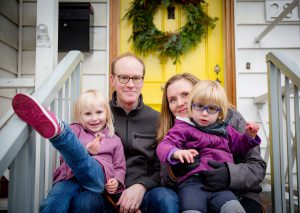
When your child is sick with a rare condition that can’t be named, the search for an answer can seem frustrating and hopeless. For Kirk and Emmy Anderson, navigating the lengthy diagnostic process for their daughter, Wren, was something they endured with the hope that an answer would eventually come.
By about 6 months of age, Kirk and Emmy noticed that Wren was not meeting her developmental milestones. After a febrile seizure led to a stay in in Seattle Children’s Neonatal Intensive Care Unit (NICU), they received the news that a brain MRI showed Wren had a decrease in the amount of white matter in the brain, as well as a fluid filled sack growing between her brain and spinal cord. Despite the findings, doctors didn’t yet know what was causing these issues to arise.
Wren spent the next three years consulting with multiple departments at Seattle Children’s including pediatrics, neurology, neurosurgery, rehabilitation medicine and genetics, undergoing a series of tests and exams. One of Wren’s doctors, geneticist Dr. James Bennett, refers to this period as her “diagnostic odyssey.”

“As things moved forward, we learned to adjust our outlook as the diagnostic journey progressed,” Emmy said. “We remember Dr. Bennett telling us that it could take several years. That really helped us set our expectations and be patient with the process.”
Finding an answer through exome sequencing
A conclusive diagnosis continued to elude Wren’s doctors. The Andersons were beginning to accept that they may never know exactly what was causing Wren’s developmental delays, but always held out hope that they would get information that would help them meet Wren’s unique needs.
Bennett encouraged them by explaining, “Genetics are like a cell phone. They go out of date every three years, so just because you didn’t get a diagnosis today, don’t give up.”
Bennett’s statement proved correct; exome sequencing provided the answer they had been searching for. Exome sequencing examines almost all of the genes in a person’s genome at once, and can pinpoint mutations that may be causing disease. Five years ago this test was not widely available, but it is starting to be used more frequently today. Wren, now nearly 4 years old, was finally diagnosed with an extremely rare genetic condition known as Hereditary Spastic Paraplegia type 47, or SPG47 for short.
SPG47 symptoms can mimic those of cerebral palsy. It affects speech and language, mobility and other motor functions. Bennett said that due to the closely related symptoms, SPG47 may be misdiagnosed as cerebral palsy or not diagnosed at all.
To classify the disease as rare is an understatement. At the time Bennett pinpointed the diagnosis, less than a dozen cases were known which made finding information about the disease very challenging. According to Cure SPG47, there are currently only 14 documented cases in the world. Bennett believes that awareness of the condition and the availability of exome sequencing will likely lead to greater numbers in the near future.
Finding solace in connection
For Wren and her family, they were comforted to finally have an answer after years of searching. Knowing her diagnosis also allowed them the opportunity to connect with other families across the country via social media to talk about the various ups and downs of having a child with SPG47. Within a week of the diagnosis, Emmy and Kirk had communicated with two other families who were able to answer questions and identify with all the things they were going through.
“Knowing you’re not alone and connecting with others who share the same rare experience has been incredibly valuable,” said Emmy. “Parenting a child with such a specific set of symptoms and severe delays is lonely and you can feel like the only one. After finding the other families, I immediately felt understood and supported without having to explain our situation, and their lovely children reminded me so much of our little bird, Wren.”
Emmy and Kirk are now committed to working with other families to advance research and find treatments for SPG47. As they live their lives, they’re determined to enjoy their time as a family through activities like spontaneous dance parties in their kitchen and are always thinking of the best way to care for Wren as she grows.

“We always say ‘Wren is Wren’ and we marvel at her steady progress,” Emmy said. “She completed our family and we love her beyond measure.”
Emmy encourages other families who may someday have to deal with a rare diagnosis to reach out for help and camaraderie.
“We can rely on each other and share resources to help our children reach their full potential,” Emmy said.
The bottom line for Wren and her family is the knowledge they are not alone and they say that in itself is powerful medicine.

